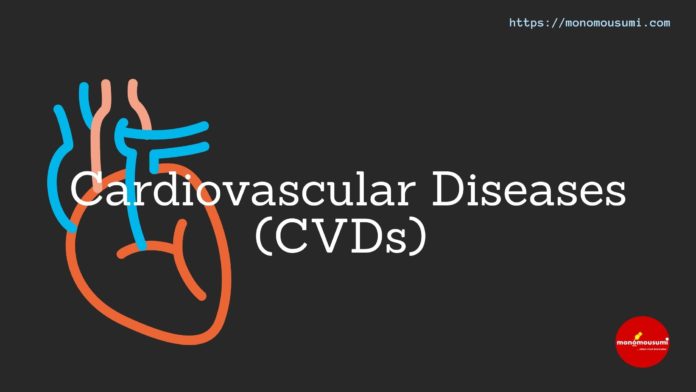We are all affectionate in our hearts, aren’t we? Then, why have cardiovascular diseases been the number 1 cause of death globally (except for Africa), taking away an estimated 17.9 million lives every year? Of these deaths, 85% were caused due to heart attack or stroke. If we really don’t want our lives to fall under the catastrophic realm of cardiovascular diseases, it’s vital to comprehend them.
The cardiovascular, or circulatory, system consists of the heart, arteries, veins, and capillaries, all of whose job is to supply the body with blood. Cardiovascular disease (CVD) is an umbrella term for a number of linked pathologies related to the heart or the other components of the circulatory system.
CVDs are of four major types: Coronary heart disease (occurs when the flow of oxygen-rich blood to the heart muscle is blocked or reduced, causing angina, heart attacks and heart failure.), stroke (occurs when blood supply to part of the brain is cut off, which can cause brain damage and possibly death.), peripheral arterial disease (occurs when there is a blockage in the arteries to the limbs, usually the legs.), aortic diseases (a group of conditions affecting the aorta, the largest blood vessel in the body, which carries blood from the heart to the rest of the body.)
While the causes of these pathologies aren’t quite clear, there are certain factors which contribute to their occurrence, called the risk factors. Well, cardiovascular diseases have numerous risk factors. Some of these are unfortunately unavoidable. Perhaps, the most unavoidable one is genetic influence. It is claimed that cardiovascular disease in a person’s parents increases their risk by 3 folds. Next, age is the most important risk factor in developing cardiovascular or heart diseases. Approximately, the risk triples with each decade of life. It is suggested that 82 percent of the individuals who die of coronary heart disease are 65 or older. One of the studies suggests the reason is serum cholesterol level, which in most populations, increases as age increases. Sex also plays a role, because men are at greater risk of heart disease than pre-menopausal women. Middle-aged men are 2 to 5 times more vulnerable to coronary heart diseases than women. However, if a female has diabetes, she is more likely to develop heart disease than a male with diabetes.
But fortunately, most of the factors are preventable. Perhaps, the most significant one is physical inactivity, mentioned as the fourth leading cause. In 2008, 31.3% of adults aged 15 or older (28.2% men and 34.4% women) were found to be insufficiently physically active. High dietary intakes of saturated fat, trans-fat, salt and low intake of fruits, vegetables and fish are linked to cardiovascular risk. Recurrent consumption of high-energy foods, such as processed foods (that are high in fats and sugars) promotes obesity and may also aggregate cardiovascular risk. Also, high alcohol consumption is directly associated with cardiovascular diseases. Tobacco is another major cause which contributes to bad cardiovascular health. Apart from these causes, obesity, raised blood pressure, blood sugar and high level of cholesterol and an overall unhealthy lifestyle leads to a hike of our chances to catch cardiovascular diseases.
All the victims of cardiovascular diseases have at least one risk factor. Upto 90% of cardiovascular diseases are preventable if mutable risk factors are avoided; and it’s purely the responsibility of individuals as well as the government. So, let’s have a look at what individuals and the government can do in reducing our risk of cardiovascular diseases.
Individuals can initiate by taking little steps. Taking a perfectly balanced diet, having a variety of foods, like fruits and vegetables, less salt sugar, saturated or industry-processed trans-fat and less cholesterol does the most part in avoiding cardiovascular diseases. Pay heed to the phrase “Hara Hachi Bu” or “the 80 percent rule” meaning “feel your belly to only 80 percent”. Getting out of the cosy zone, even if it seems unbearable, is essential for our cardiovascular health. Participating in 150 minutes (2 hours and 30 minutes) of moderate exercise per week and a warm 7-9 hours of sleep promote good heart health too. A few yoga stretches, China’s “Tai Chai” and “Quigong” are a few enough workouts to promote heart health and peace.
Avoiding smoking as well as second-hand smoke outdoors, reduces the risk of CDVs by 35%. People who moderately consume alcoholic drinks have a 25–30% lower risk of cardiovascular disease too. It is estimated that high blood pressure accounts for approximately 13% of CVD deaths, while tobacco accounts for 9%, diabetes 6%, lack of exercise 6% and obesity 5%. A normal blood pressure level is essential. A 10 mmHg decline in blood pressure lessens the risk by about 20%. Being fit and not obese promotes a better heart because a fat body makes the heart to work much harder making it vulnerable to diseases. Having a stable, stimulating and positive atmosphere is the best way to reduce psychological stress and sustain overall health.
Individuals must involve themselves in these healthy practises with their youngsters, take part in campaigns and school awareness programs, and also preach to the community. The government must establish more and more health centres and labs for testing, treating, facilitating and advancing, forecast advertisements and programs, and launch camps and campaigns, with a motto to create awareness in the society.
To condense up, it’s a matter of a mere choice whether one wants to live a healthy, impactful and productive life or be bed- ridden on the tenterhooks of a miracle. The first preference would be fair, and honestly, it’s not much of a big deal. Just eat lightly, move frequently, breathe deeply, quit smoking and cultivate jollity in your life.
And apparently, if people don’t come on the right track soon enough, our future is vulnerable.
By Mahisha Ahmed
















